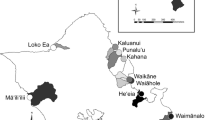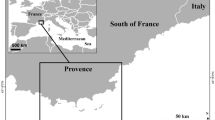Abstract
While juvenile Atlantic goliath grouper, Epinephelus itajara (Lichtenstein, 1822), are known to depend on mangrove root structure, relationships with water properties (e.g., salinity) and depth remain unclear or understudied. Because availability of suitable mangrove habitat has been suggested as the primary bottleneck to the recovery of this threatened species in the US, we investigated habitat associations of juvenile Atlantic goliath grouper with respect to physical water properties within mangrove habitats. Our study was conducted in six coastal rivers and three canals within the Ten Thousand Islands region of southwest Florida. Results suggested that juvenile Atlantic goliath grouper differed in how they associated with specific mangrove habitats based on season and size. We found that smaller juveniles (<340 mm TL) appeared to have stronger associations to physical water characteristics than larger (≥340 mm TL) juveniles. Both large and small juveniles showed the strongest associations with DO (i.e., >3 mg L−1) within mangrove habitat. For small juveniles, extreme temperatures influenced habitat association; for large juveniles, extreme salinity influenced distribution. We also found evidence that juvenile Atlantic goliath grouper associated more with natural rivers over man-made canals. The present study has utility for delineating suitable mangrove habitats for protection and potentially in the design of sampling surveys that aim to estimate population abundance.






Similar content being viewed by others
References
Akaike H (1973) Information theory as an extension of the maximum likelihood principle. In: Petrov BN, Csaki FF (eds) Second International Symposium of Information Theory. p 267–281
Burnham KP, Anderson DR (2002) Model selection and multimodel inference: a practical information-theoretic approach, 2nd edn. Springer, New York, 488 p
Cass-Calay SL, Schmidt TW (2009) Monitoring changes in the catch rates and abundance of juvenile goliath grouper using the ENP creel survey, 1973–2006. Endanger Species Res 7:183–193. doi:10.3354/esr00139
Chambers RL, Dunstan R (1986) Estimating distribution functions from survey data. Biometrika 73:597–604. doi:10.1093/biomet/73.3.597
Chapman FA, García LN, Atencio VJ, Muñoz RJ, Silva A, Flores H (2014) Low-salinity acclimation of juvenile marine goliath grouper Epinephelus itajara. J Appl Aquacult 26:179–186. doi:10.1080/10454438.2014.905356
Doyle TW, Krauss KW, Wells CJ (2009) Landscape analysis and pattern of hurricane impact and circulation on mangrove forests of the Everglades. Wetlands 29(1):44–53. doi:10.1672/07-233.1
Faunce CH, Serafy JE (2006) Mangroves as fish habitat: 50 years of field studies. Mar Ecol Prog Ser 318:1–18. doi:10.3354/meps318001
Fletcher D, MacKenzie D, Villouts E (2005) Modelling skewed data with many zeros: a simple approach combining ordinary and logistic regression. Environ Ecol Stat 12:45–54
Florida Climate Center (2014) Everglades. Accessed 17 May, 2014. Center for Ocean-Atmospheric Prediction Studies. Available from: http://climatecenter.fsu.edu/products-services/data/1981-2010-normals/everglades
Frias-Torres S (2006) Habitat use of juvenile goliath grouper Epinephelus itajara in the Florida Keys, USA. Endanger Species Res 2:1–6. doi:10.3354/esr002001
Frias-Torres S, Barroso P, Eklund A-M, Schull J, Serafy JE (2007) Activity patterns of three juvenile goliath grouper, Epinephelus itajara, in a mangrove nursery. Bull Mar Sci 80:587–594
Gilmore RG, Bullock LH, Berry FH (1978) Hypothermal mortality in marine fishes of south-central Florida. Northeast Gulf Sci 2:77–97
Gratwicke B, Petrovic C, Speight MR (2006) Fish distribution and ontogenetic habitat preferences in non-estuarine lagoons and adjacent reefs. Environ Biol Fish 76(2–4):191–210
Hastie TJ, Tibshirani RJ (1990) Generalized additive models. Vol. 43. CRC Press
International Union for the Conservation of Nature (IUCN) (2014) The IUCN red list of threatened species. Accessed 19 February, 2014. Available from: http://www.iucnredlist.org
Koenig CC, Coleman FC, Eklund A-M, Schull J, Ueland J (2007) Mangroves as essential nursery habitat for goliath grouper (Epinephelus itajara). Bull Mar Sci 80(3):567–586
Koenig CC, Coleman FC, Kingon K (2011) Pattern of recovery of the goliath grouper Epinephelus itajara population in the southeastern US. Bull Mar Sci 87(4):891–911. doi:10.5343/bms.2010.1056
Krebs JM, Brame AB, McIvor CC (2007) Altered mangrove wetlands as habitat for estuarine nekton: are dredged channels and tidal creeks equivalent? Bull Mar Sci 80(3):839–861
Lara MR, Schull J, Jones DL, Allman R (2009) Early life history stages of goliath grouper Epinephelus itajara (Pisces: Epinephelidae) from Ten Thousand Islands, Florida. Endanger Species Res 7:221–228. doi:10.3354/esr00193
McManus LC, Yurek S, Teare PB, Dolan TE, Serafy JE (2014) Killifish habitat suitability as a measure of coastal restoration performance: integrating field data, behavioral trials and simulation. Ecol Indic 44:173–181. doi:10.1016/j.ecolind.2014.03.006
Mumby PJ, Edwards AJ, Arias-Gonzalez JE, Lindeman KC, Blackwell PG, Gall A, Gorczynska MI, Harborne AR, Pescod CL, Renken H, Wabnitz CCC, Llewellyn G (2004) Mangroves enhance the biomass of coral reef fish communities in the Caribbean. Nature 427:533–536. doi:10.1038/nature02286
Nagelkerken I, Roberts CM, van der Velde G, Dorenbosch M, van Riel MC, Cocheret de la Morinière E, Nienhuis PH (2002) How important are mangroves and seagrass beds for coral-reef fish? The nursery hypothesis tested on an island scale. Mar Ecol Prog Ser 244:299–305. doi:10.3354/meps244299
Perry W (2004) Elements of south Florida’s comprehensive everglades resoration plan. Ecotoxicology 13:185–193
Perry RI, Smith SJ (1994) Identifying habitat associations of marine fishes using survey data: an application to the northwest Atlantic. Can J Fish Aquat Sci 51:589–602. doi:10.1139/f94-061
Poulakis GR, Stevens PW, Timmers AA, Stafford CJ, Simpfendorfer CA (2013) Movements of juvenile endangered smalltooth sawfish, Pristis pectinata, in an estuarine river system: use of non-main-stem river habitats and lagged responses to freshwater inflow-related changes. Environ Biol Fish 96(6):763–778. doi:10.1007/s10641-012-0070-x
Quisthoudt K, Schmitz N, Randin CF, Dahdouh-Guebas F, Robert EMR, Koedam N (2012) Temperature variation among mangrove latitudinal range limits worldwide. Trees 26(6):1919–1931. doi:10.1007/s00468-012-0760-1
R Core Team (2012) R: a language and environment for statistical computing. R Foundation for Statistical Computing, Vienna, Austria. ISBN 3-900051-07-0, Available from: http://www.R-project.org/
Reynolds JA (2003) Quantifying habitat associations in marine fisheries: a generalization of the Kolmogorov-Smirnov statistic using commercial logbook records linked to archived environmental data. Can J Fish Aquat Sci 60:370–378. doi:10.1139/f03-032
Sadovy Y, Eklund A-M (1999) Synopsis of biological data on the Nassau grouper, Epinephelus striatus (Bloch, 1792), and the jewfish, E. itajara (Lichtenstein, 1822). NOAA Techincal Report NMFS 146, 65 p
Sagarese SR, Frisk MG, Miller TJ, Sosebee KA, Musick JA, Rago PJ (2014a) Influence of environmental, spatial, and ontogenetic variables on habitat selection and management of spiny dogfish in the Northeast (US) shelf large marine ecosystem. Can J Fish Aquat Sci 71(4):567–580. doi:10.1139/cjfas-2013-0259
Sagarese SR, Frisk MG, Miller TJ, Sosebee KA, Musick JA, Rago PJ (2014b) Application of generalized additive models to examine ontogenetic and seasonal distributions of spiny dogfish (Squalus acanthias) in the Northeast (US) shelf large marine ecosystem. Can J Fish Aquat Sci 71(6):847–877. doi:10.1139/cjfas-2013-0342
SEDAR (Southeast Data, Assessment, and Review) (2011) SEDAR 23 stock assessment report. South Atlantic and Gulf of Mexico goliath grouper, North Charleston, 248 p
Serafy JE, Valle M, Faunce CH, Lou J (2007) Species- specific patterns of fish abundance and size along a subtropical mangrove shoreline: an application of the Delta approach. Bull Mar Sci 80(3):609–624
Serrano X, Grosell M, Serafy JE (2010) Salinity selection and preference of the grey snapper Lutjanus griseus: field and laboratory observations. J Fish Biol 76:1592–1608. doi:10.1111/j.1095-8649.2010.02585.x
Valentine-Rose L, Layman CA, Arrington DA, Rypel AL (2007) Habitat fragmentation decreases fish secondary production in Bahamian tidal creeks. Bull Mar Sci 80(3):863–877
Zuur A, Ieno EN, Walker N, Saveliev AA, Smith GM (2009) Mixed effects models and extensions in ecology with R. Springer; 2009 edn. 574 p
Acknowledgments
This work was supported by the Southeast Fisheries Science Center. We thank A Shideler for assistance with data processing and analysis and A-M Eklund, C Koenig, and F Coleman for initiating the juvenile goliath grouper sampling described here, and thanks to M Finn for doing the lionshare of the work on deploying and recovering traps. This research was conducted under the guidelines of the Florida State University Animal Care and Use Committee and under permits from the Florida Fish and Wildlife Conservation Commission.
Author information
Authors and Affiliations
Corresponding author
Rights and permissions
About this article
Cite this article
Shideler, G.S., Sagarese, S.R., Harford, W.J. et al. Assessing the suitability of mangrove habitats for juvenile Atlantic goliath grouper. Environ Biol Fish 98, 2067–2082 (2015). https://doi.org/10.1007/s10641-015-0430-4
Received:
Accepted:
Published:
Issue Date:
DOI: https://doi.org/10.1007/s10641-015-0430-4




